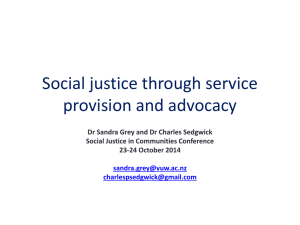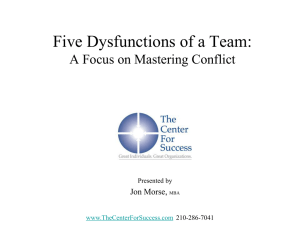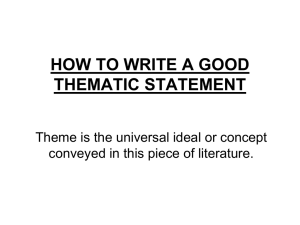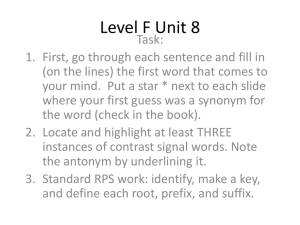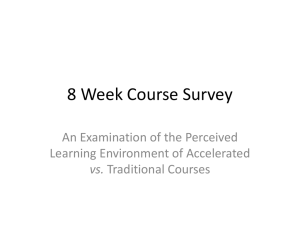Fundamental #4 Embracing Accountability
advertisement
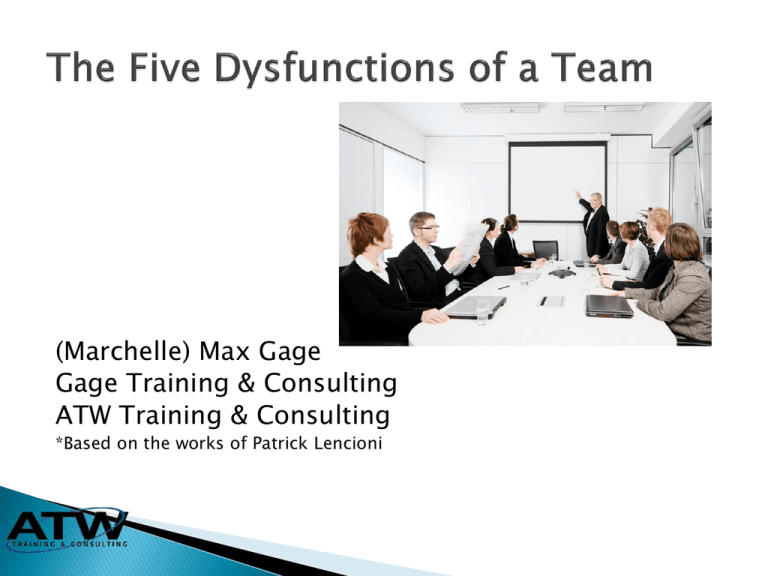
(Marchelle) Max Gage Gage Training & Consulting ATW Training & Consulting *Based on the works of Patrick Lencioni (Marchelle) Max Gage ◦ Training/development 22 years ◦ Full time training consultant Meredith EDS Wells Fargo American Media 15 years Management development Customer service Sales skills Presentation skills Team building ◦ Independent training consultant ◦ Adjunct instructor—Drake Understand the behaviors that most commonly derail teams Appreciate the “Five Dysfunctions of a Team” Quick Assessment ◦ Review instructions ◦ Think of your current team, or the team you spend most time with ◦ Use scale (1-3) in rating ◦ Complete individually Transfer scores to scoring sheet Do calculations Be prepared to share scores This is a “benchmark”—not a report card! ◦ Strengths/areas for improvement ◦ Tool to help us decide on changes we want to make As you look at your scores, where are you… ◦ Strong ◦ Needing improvement ◦ Concerned ◦ Let’s start with “trust”—it is the foundation for building a team. Members of great teams trust one another on a fundamental, emotional level, and they are comfortable being vulnerable with each other about their weaknesses, mistakes, fears, and behaviors. They get to a point where they can be completely open with one another, without filters. Partner Review questions Be prepared to answer questions ◦ Where did you grow up? What was it like to live there? ◦ What was your first job? Your worst job? Each person has 3-4 minutes to share responses to questions What did you learn about your colleagues that you did not know? How can this help your team? How could you implement with your team? Trust is the foundation of teamwork. • On a team, trust is all about vulnerability, which is difficult for most people. • Building trust takes time, but the process can be greatly accelerated. • Like a good relationship, trust on a team is never complete; it must be maintained over time. • Colors DiSC Myers-Briggs Relationship Strategies What do you know about yourself that might affect your perception of and ability to engage in conflict? What was the conflict environment in your home while you were growing up? Were there spirited conversations, or did you family avoid difficult conversations? And… Teams that trust one another are not afraid to engage in passionate dialogue around issues and decisions that are key to the organization's success. They do not hesitate to disagree with, challenge, and question one another, all in the spirit of finding the best answers, discovering the truth, and making great decisions. People’s viewpoints on, and comfort levels with conflict differ! It’s important for a team to understand how individual members view and deal with conflict, so a conflict culture that everyone can understand can be established. In what geographic area were you raised? What conflict style was accepted and expected? What professional experiences have influenced your ability to engage in unfiltered debate? What did you learn about your colleagues’ background and experience with conflict that you did not know? How might this information affect your team’s ability to engage in meaningful conflict? Provide clarity about how we expect each to engage in discussion and debate in the team. ◦ What kind of language and tone of voice should be used in meaningful conflict situations? ◦ What emotions should be evident? What emotions should be suppressed? ◦ To what extent should team members be involved and participate in the conflict? ◦ What other expectations do you have? Good conflict among team members requires trust, which is all about engaging in passionate, unfiltered debate. • Conflict will at times be uncomfortable. • Conflict norms must be discussed and made clear among the team. • The fear of conflict should not deter a team from having regular, meaningful, productive debate. • Teams that engage in unfiltered conflict are able to achieve genuine buy-in around important decisions, even when various members of the team initially disagree. That is because they ensure that all opinions and ideas are put on the table and considered, giving confidence to team members that no stone has been left unturned. A Thematic Goal is a single overriding theme that remains the top priority of the entire team for a give period of time. Elements include: ◦ ◦ ◦ ◦ Single Qualitative Time-bound Shared Write down your answer to this question: ◦ What do you think is the single most important goal to achieve during the next _______ months if our team is to consider itself successful? Defining Objectives (to support thematic goal) Stand Operating Objectives (always important, do not go away) Principles that your team agree to: ◦ The structure and schedule for meetings ◦ Acceptable behavior during meetings ◦ The extent to which being on time to meetings is a priority ◦ The preferred methods (email, text, etc.) for communicating with one another and the norms around how to use each method ◦ The timeliness of responding to one another ◦ The use of shared resources The level of freedom we have when interacting with one another's staff) ◦ The extent to which we will be available during non-work hours for meetings or to answer questions Commitment requires clarity and buy-in. • Clarity requires that teams avoid assumptions and ambiguity, and that they end discussions with a clear understanding about what they’ve decided on. • Buy-in does not require consensus— team members can disagree and still commit to decisions. • Teams that commit to decisions and standards of performance do not hesitate to hold one another accountable for adhering to those decision and standards. What’s more, they don’t rely on the team leader as the primary source of accountability, they go directly to their peers. Situation OR Task Action Result Alternative Action Alternative Result *Development Dimensions International “During our departmental meeting yesterday (Situation), I saw you roll your eyes, frown, and roll back your chair away from the table when Roberta offered her suggestions on the project (Action). When you did this, I felt you were not open to what she had to say and may have caused her to feel less valued as a contributor.” (Result) Next time when you disagree with what Roberta has to say, capture your thoughts on paper and refrain from moving away from the table (Alternative Action). She will be able to complete her thoughts and then we can listen to your perspective (Alternative Result). Used at beginning of regular meetings Ask team members to each take no more than 30 seconds to update the team about their 3 top priorities that week. If anyone on the team feels that a given team member is spending time unwisely, or that there is greater need for a person’s time and energy to another area, this is the place to call the question. **Assumes a level of trust, openness to conflict, and original commitment to the team’s goals.** Accountability on strong teams occurs directly among peers. • Peer pressure and distaste of letting down colleagues will motivate a team player more than fear of punishment or rebuke. For a culture of accountability to thrive, the team leader must demonstrate willingness to confront difficult issues. • • Teams that trust one another, engage in conflict, commit to decisions, and hold one another accountable, are very likely to set aside their individual needs and agendas and focus almost exclusively on what is best for the team. They do not give in to the temptation to place their departments, career aspirations, or ego-drive status ahead of the collective results that define team success. Stay focused on the right priorities— your collective results—so that you aren’t distracted by something else. Our Thematic Goal ◦ How will we know when we have reached our Thematic Goal? ◦ What are some ways in which we can track progress toward our goal? ◦ What kind of “scorecard” will help us stay focused on the goal and able to see our progress? Great teams accomplish the results they set out to achieve. • Team members must prioritize the team’s collective results over individual (or departmental) needs. • Teams must publicly clarify desired results and keep them visible. •

